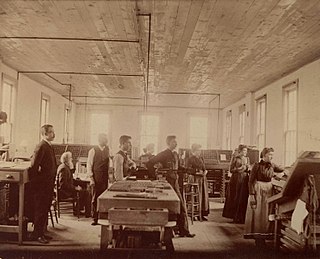Related Research Articles

Lancaster County, sometimes nicknamed the Garden Spot of America or Pennsylvania Dutch Country, is a county in the Commonwealth of Pennsylvania. It is located in the south central part of Pennsylvania. As of the 2020 census, the population was 552,984. Its county seat is Lancaster. Lancaster County comprises the Lancaster, Pennsylvania metropolitan statistical area.
Hans Herr was born in Zürich, Switzerland. While often cited as a descendant of the knight Hugo Herr, scholarship done in the 20th century has put this claim in doubt. He joined the Swiss Brethren and became a bishop. He was the first Mennonite bishop to emigrate to America.

Martyr's Mirror or The Bloody Theater, first published in Holland in 1660 in Dutch by Thieleman J. van Braght, documents the stories and testimonies of Christian martyrs, especially Anabaptists. The full title of the book is The Bloody Theater or Martyrs Mirror of the Defenseless Christians who baptized only upon confession of faith, and who suffered and died for the testimony of Jesus, their Saviour, from the time of Christ to the year A.D. 1660. The use of the word defenseless in this case refers to the Anabaptist belief in non-resistance. The book includes accounts of the martyrdom of the apostles and the stories of martyrs from previous centuries with beliefs similar to the Anabaptists.
The Mennonite Historical Library (MHL) is considered the world's most prominent and complete collection of resources and artifacts pertaining to Mennonites and related Anabaptist groups. It is housed in the Harold and Wilma Good Library on the campus of Goshen College in Goshen, Indiana. The specialty library was founded in 1906 under the guidance of Harold S. Bender and Ernst Correll. Historian John D. Roth is the current director.

The Landis Valley Village & Farm Museum is a 100-acre living history museum located on the site of a former rural crossroads village in Lancaster, Pennsylvania. Founded by brothers Henry K. Landis and George Landis in 1925 and incorporated in 1941, it is now operated by the Pennsylvania Historical and Museum Commission. Its staff and volunteers collect, conserve, exhibit, and interpret Pennsylvania German material, culture, history and heritage from 1740 through 1940.
John A. Hostetler was an American author, educator, and scholar of Amish and Hutterite societies. Some of his works are still in print.

Abraham Herr Smith was an American politician who served as a Republican member of the U.S. House of Representatives for Pennsylvania's 9th congressional district from 1873 to 1885.
John Fretz Funk was a publisher and leader of the Mennonite Church. Funk published the Herald of Truth from 1864 until 1908 when it merged with the Gospel Witness to form the Gospel Herald. Jacob Clemens Kolb, in his preface to Bless the Lord, O My Soul quotes an unnamed commentator who said, "John F. Funk is the most important [Mennonite] man after Menno Simons."
Lancaster Mennonite Conference (LMC) is a historic body of Mennonite churches in the Mid-Atlantic region of the United States, consisting of Pennsylvania, New Jersey, New York, and Maryland. There are also a few conference churches in Delaware, Virginia, and the city of Washington, D.C., as well as two located in Hawaii. The conference was briefly (2002-2015) associated with the newly formed Mennonite Church USA.
The Mennonite Church USA Archives was founded in 2001 under the denominational merger of the (old) Mennonite Church and the General Conference Mennonite Church. Prior to 2001, the two largest Mennonite denominations maintained separate archives: the Archives of the Mennonite Church, located on the Goshen College campus, housed materials pertaining to the (old) Mennonite Church, while the Mennonite Library and Archives on the Bethel College campus held the records of the General Conference Mennonite Church.
Peter J. Dyck was a Canadian Mennonite relief worker and pastor best known for his work resettling Russian Mennonite refugees after World War II.
The Women's Missionary and Service Commission, previously known as the Women's Missionary and Service Auxiliary and abbreviated WMSC or WMSA, was a women's organization of the "old" Mennonite Church that originated out of the Mennonite Sewing Circle movement. Named the WMSC in 1971, there were many precursor organizations and it has since evolved into Mennonite Women USA, an organization with a much wider scope.

The Hans Herr House, also known as the Christian Herr House, is a historic home located in West Lampeter Township, Lancaster County, Pennsylvania. It was built in 1719, and is a 1+1⁄2-story, rectangular sandstone Germanic dwelling. It measures 37 feet, 9 inches, by 30 feet, 10 inches. It is the oldest dwelling in Lancaster County and the oldest Mennonite meetinghouse in America.
College Mennonite Church (CMC) is a Mennonite Church located in Goshen, Indiana, and a member of the Indiana-Michigan Mennonite Conference of Mennonite Church USA.

The Mennonite Publishing Company was a publishing agency in Elkhart, Indiana, operating primarily from 1875-1908, which under John F. Funk served as the main source of published material for the (old) Mennonite Church. The Mennonite Publishing Company was the third and final agency through which Funk published a great deal of historical and denominational Mennonite texts and periodicals, having previously published as "John F. Funk" from 1864-1869 and "John F. Funk and Brother" from 1869-1874.
Heinrich Funck was a mill operator, religious author and a Mennonite bishop in America.

The Hess Homestead, in Lancaster County, Pennsylvania, is a historic Mennonite farmstead near the town of Lititz. The property is an ancestral home of the Hess family, who purchased the land from William Penn's sons in 1735.

John Horsch was a Mennonite historian and writer.
References
- 1 2 Ira D. Landis (1950). The Landis Family Book. Landis, 1950-1955.
- 1 2 3 "History of LMHS". 17 June 2021.
- ↑ "Select Letters between Bender and Landis".
- ↑ Mennonite Research Journal
- 1 2 Martyrs Mirror 1964. OCLC 10243771.
- ↑ "National Historic Landmarks & National Register of Historic Places in Pennsylvania". CRGIS: Cultural Resources Geographic Information System. Archived from the original (Searchable database) on 2007-07-21. Retrieved 2021-10-11.